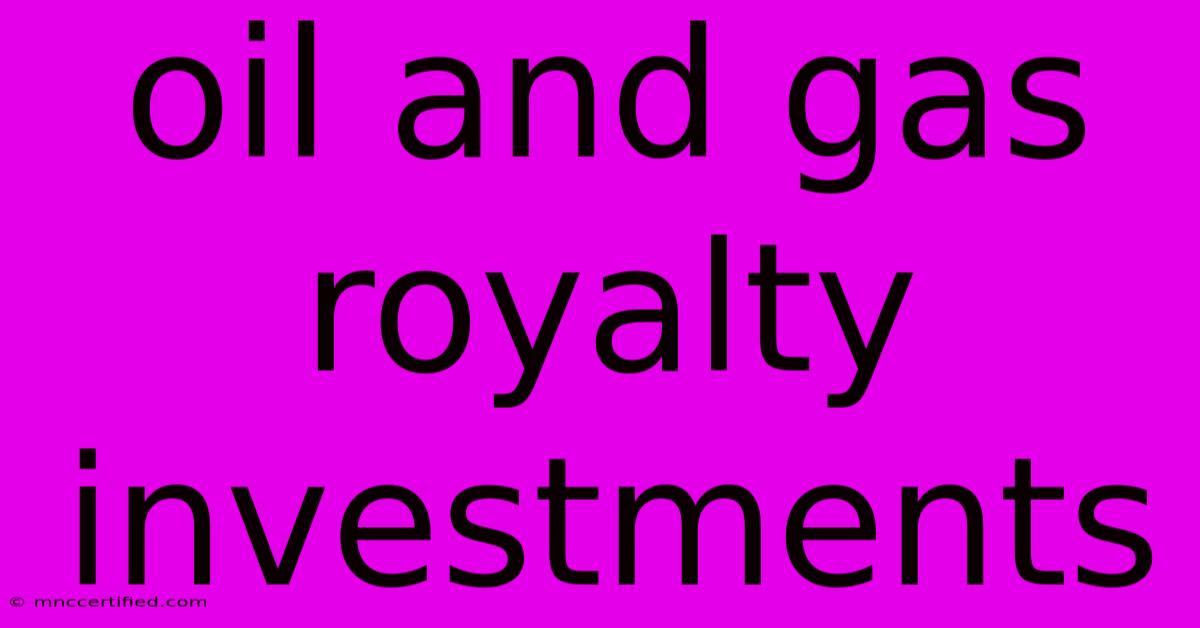Oil And Gas Royalty Investments

Table of Contents
Oil and Gas Royalty Investments: A Comprehensive Guide
Oil and gas royalty investments offer a unique opportunity to participate in the energy sector without the operational headaches of drilling and production. This guide explores the ins and outs of these investments, helping you understand the potential rewards and risks involved.
What are Oil and Gas Royalties?
Oil and gas royalties represent a percentage of the revenue generated from the sale of oil and gas produced from a specific well or property. Royalty owners are entitled to this share regardless of the operating company's success or failure in extracting and selling the resources. This passive income stream makes royalty interests attractive to investors seeking diversification and potentially high returns.
Types of Royalty Interests:
- Working Interest: This involves a direct participation in the costs and profits of oil and gas production. It's a more active and riskier investment compared to royalties.
- Overriding Royalty Interest (ORRI): An ORRI is a royalty interest carved out of a working interest. The owner of the ORRI receives a share of the production revenue, but doesn't participate in operating expenses.
- Mineral Rights: These are the underlying ownership rights to the oil and gas beneath the surface of a property. Royalties are typically derived from mineral rights ownership.
Advantages of Oil and Gas Royalty Investments
- Passive Income: Royalties provide a passive income stream, requiring minimal active management from the investor.
- Inflation Hedge: Oil and gas prices often rise with inflation, potentially protecting your investment's value.
- Diversification: Royalty investments offer diversification beyond traditional asset classes like stocks and bonds.
- Long-Term Potential: Producing wells can generate income for decades, providing a steady stream of returns.
Risks of Oil and Gas Royalty Investments
- Price Volatility: Oil and gas prices are subject to significant fluctuations, impacting the value of your royalty payments. Geopolitical events, supply chain disruptions, and changing demand all influence prices.
- Production Decline: Well production naturally declines over time, leading to a reduction in royalty payments.
- Operational Risks: Unexpected operational issues, such as equipment failures or environmental concerns, can disrupt production and payments.
- Lease Expiration: The underlying lease agreement governing the production has a finite lifespan, after which payments cease.
- Due Diligence Challenges: Evaluating the potential of a specific royalty interest requires significant research and analysis, and may necessitate the hiring of experts. Understanding the geological characteristics, production history, and remaining reserves is crucial.
How to Invest in Oil and Gas Royalties
Investing in oil and gas royalties can be done through several avenues:
- Direct Purchase: This involves purchasing mineral rights or royalty interests directly from landowners or other investors. This method often requires extensive due diligence and potentially legal counsel.
- Private Equity Funds: Several private equity funds specialize in oil and gas royalty investments, offering a managed approach to investing in the sector.
- Publicly Traded Companies: Some companies are publicly traded and focus on acquiring and managing oil and gas royalties.
Due Diligence: Crucial for Success
Thorough due diligence is paramount before investing in oil and gas royalties. Key aspects to investigate include:
- Lease Terms: Understand the lease's duration, production terms, and any potential restrictions.
- Production History: Analyze historical production data to assess the well's performance and future potential.
- Geological Assessment: Evaluate the remaining reserves and the potential for future production.
- Regulatory Compliance: Ensure the property and operations comply with all applicable environmental regulations.
- Financial Statements: If buying from a company, thoroughly review their financial performance.
Conclusion: Weighing the Potential
Oil and gas royalty investments offer the allure of passive income and potential high returns. However, the inherent risks associated with commodity price volatility and production decline require careful consideration. Conducting thorough due diligence, understanding the various types of royalty interests, and potentially seeking professional advice are crucial steps to make informed investment decisions in this sector. Remember, this is not a get-rich-quick scheme, but rather a long-term investment that needs careful planning and research.

Thank you for visiting our website wich cover about Oil And Gas Royalty Investments. We hope the information provided has been useful to you. Feel free to contact us if you have any questions or need further assistance. See you next time and dont miss to bookmark.
Featured Posts
-
New Developments In Jon Benet Ramsey Case
Nov 26, 2024
-
U Conn Leaving The Maui Invitational
Nov 26, 2024
-
Newcastle 0 2 West Ham Game Recap
Nov 26, 2024
-
Shadow In Sonic 3 Movie Trailer
Nov 26, 2024
-
Erie Insurance Shepherdstown Wv
Nov 26, 2024